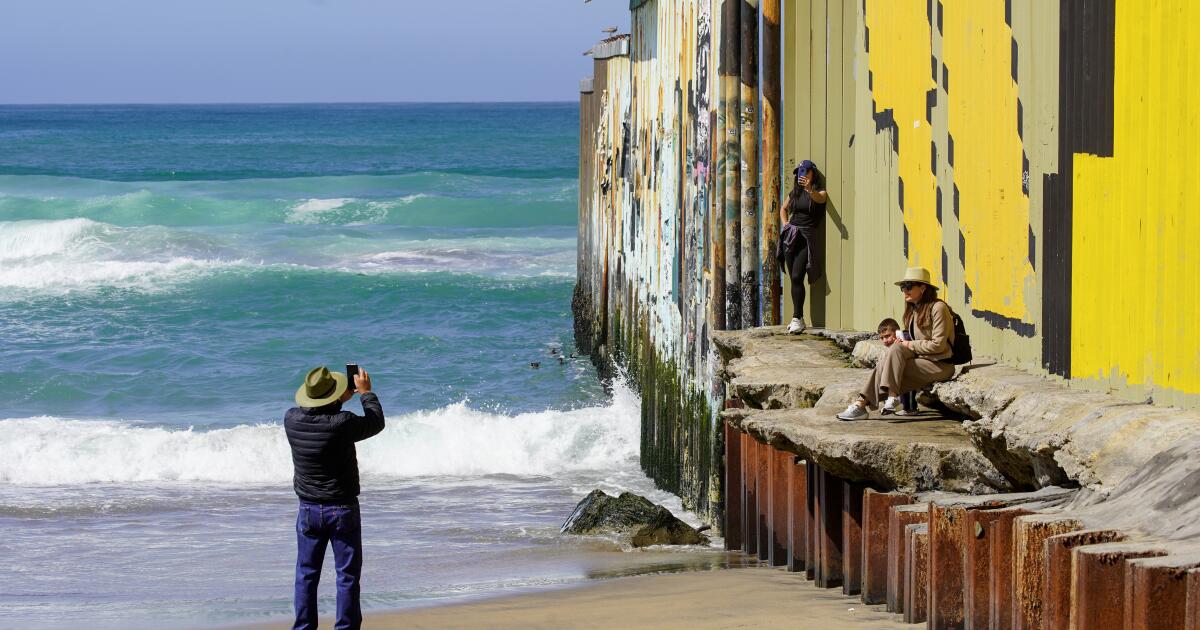
Migrant drowning deaths along the San Diego County coastline spiked in the four years after sections of the U.S.-Mexico border wall were replaced with taller ones, according to a UC San Diego study published Thursday in the Journal of the American Medical Association.
From 2020 to 2023 — after the U.S. government began replacing the old border barrier with a mostly 30-foot bollard-style fence — 33 drowning deaths were reported in the Pacific Ocean along the county’s coast, compared with one death in the previous four years, the study said.
The paper — based on data from the Missing Migrants Project, an initiative of the International Organization for Migration, which is part of the United Nations system — includes people who drowned after crossing the border by swimming around the barrier or those who tried by boat or even personal watercraft.
The findings are in line with a well-documented rise in maritime smuggling attempts along the Southern California coastline in recent years, as well as a separate 2022 UC San Diego Health study that found border wall-related injuries and deaths in the region have spiked since the height increased.
Updated numbers shared Friday show that the number of patients treated by UC San Diego Health for injuries sustained from falling from the border wall increased from 42 in 2019 to 440 last year. Fatalities also rose from zero before 2019 to 16 in 2022.

The border wall in San Diego County has been replaced in recent years by taller, 30-foot bollard-style fencing. Some newer sections include anti-climbing panels that hook over the top.
(Alejandro Tamayo/The San Diego Union-Tribune)
“I think in general the numbers surprised me in that they were higher than I expected,” the latest study’s co-author Anna Lussier, a doctoral student at the UC San Diego School of Medicine, said of the drownings. “And I think I was most surprised by how much they have increased in the ocean in four years.”
Lussier and Dr. Peter Lindholm, a professor in UCSD’s Department of Emergency Medicine and co-author of the study, hypothesized that the new border fence’s height may have led to an increase in attempts to migrate by sea, resulting in more drownings.
Lussier, with a background in global health, and Lindholm, in human physiology in the marine environment, were exploring research topics that could incorporate both of their fields.
While doing some work on pollution exposure among lifeguards in San Diego County, the pair heard from first responders who also talked about migrant water rescues, Lussier said. The numbers seemed out of proportion to what she had seen on the news, so they decided to investigate further.
“If the numbers of drownings are increasing that is something that is important for the healthcare system to know about, and the emergency responders, lifeguards, etcétera,” Lindholm said.
Trauma hospitals in the region have become more prepared to deal with such injuries, Lussier said, something she noticed while doing her trauma surgery rotation as a medical student at UC San Diego Medical Center in Hillcrest last summer. “The health system is aware of that issue, and aware of the types of fractures that we’ve seen, the types of surgeries that might need to be done,” she said.
She hopes their research will help contribute to understanding what she called an “emergent public health issue,” including better recognition of the risk factors of those who don’t survive versus those who do.
The rise in drownings hasn’t been limited to the ocean. The study found a jump in such deaths across the U.S.-Mexico border in canals — notably the All-American Canal, which parallels the border for 80 miles in Imperial County — as well as other lakes, streams and drainage ditches.
On the Rio Grande in Texas, an area largely lacking major border wall infrastructure due to the complex environment, the numbers remained relatively stable during the same time frames.
The wall replacement project in California was largely completed under the Trump administration, switching out shorter Vietnam-era landing mat barrier with 30-foot bollards topped by smooth panels. Last year, the Biden administration resumed the project in the Friendship Park area to replace the deteriorating border structure, which takes an extra beating from the elements where it meets the sea. The new primary fence in the area consists of sections ranging from 17 to 30 feet high, some of which were built with a new anti-climbing cover at the top.

The wall at the Pacific Ocean takes a particular beating from the elements.
(Alejandro Tamayo/The San Diego Union-Tribune)
Lussier said that their research is still ongoing, and in the future they plan to look into people’s experiences of choosing a migration route and what decision-making factors are involved.
Maritime smuggling attempts along Southern California’s coastline have increased in recent years. In fiscal 2023, the Border Patrol recorded the highest number of maritime smuggling events in the San Diego Sector’s history at 736, the agency said.
Several migrants have drowned in recent years as they have tried to come ashore in overloaded boats that have been knocked over in rough seas, including when eight people died after their two boats capsized off Black’s Beach in La Jolla last March.
Many others have attempted the harrowing swim around the border fence where it juts some 80 to 90 feet into the Pacific, at the U.S.-Mexico border fence’s southwesternmost point.
Lifeguards in Tijuana warn that while the water may look calm, the currents can be dangerous even for expert swimmers.
In late October, city officials posted a sign in the Playas de Tijuana beach area — popular with both locals and tourists — warning migrants of the risks of both climbing over and swimming around the border barrier. “For your safety, do not cross the wall,” it reads.

A sign is installed at Playas de Tijuana near the border wall to warn migrants about the dangers of crossing in October.
(Ana Ramirez/The San Diego Union-Tribune)
Since January, one person has drowned and two others have been rescued on the Mexican side of the beach, said Juan Hernández, head of the water rescue division with the Tijuana Fire Department. Three others made it across the border, he added.
Lifeguards monitor the area next to the border fence constantly, Hernández said. In case of emergency, they maintain communication with U.S. Border Patrol officials on the other side, he said.
The rescue team can only intervene if the person asks for help or if there appears to be imminent danger. The risk, he said, is that people don’t assess the danger when entering the ocean. “They think it’s too easy,” he said.
Even holding onto the barrier during a crossing can be extremely dangerous, with currents that can sweep a person out to sea. “We usually tell them to think about it, not to take the risk.”
Staff writer Teri Figueroa contributed to this report.







